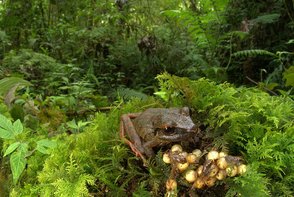

 A new lab contribution is available as Early View article today in Ecology & Evolution. The study compares variation in maximum and minimum critical temperatures of more than 20 species of craugastorid frogs in the Amazonian lowland rainforest and contiguous Andean slopes. In this region craugastorid frogs such as the Pristimantis danae female guarding over her hatchlings of the photo have diversified into what is one of the largest vertebrate radiation. As suggested by previous findings, lowland frogs seem to be at higher risk from climate warming than highland frogs, because lowland frogs are already living at temperatures that are fairly close to the maximum critical temperatures that they could tolerate. This expanded study incorporates the frog's evolutionary history and data on tolerance to cold, and tested whether tolerance to heat and cold exhibit different rates of change, given that critical thermal limits (and their plasticity) may have evolved differently in response to different temperature constraints along the gradient. Our findings indicate great variation in thermal limits, and relatively faster rates of change for tolerance to cold than tolerance to heat. Remarkably, some high-elevation species such as Bryophryne cophites tolerated temperatures as low as 0.4 degrees Celsius.  The study was led by our collaborator Rudolf von May, postdoctoral researcher in the Department of Ecology and Evolutionary Biology at the Univerisity of Michigan, shown here preparing biophysical models to measure temperatures that frogs experience in their microhabitats in the cloud forests and grasslands of Wayqecha Biological Station. See our previous blog post about substantial recent warming in these environments.
0 Comments
Leave a Reply. |
Archives
June 2024
CATENAZZI LABNews from the lab Categories |